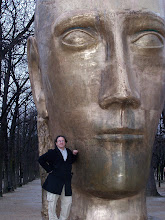
This concert is just the kind of show that I love. Two twentieth century pieces that are known but not often played (at least not here) and a gem for violin and orchestra from the late twentieth century that may never be played by the PSO. My friend, Herr Heine, asserts that an orchestra made up of talented undergrad and grad students, with lots of rehearsal time, can rival Americas better orchestras (though perhaps not our best). I will not argue the point as this show was a great example of what he was going on about.
Britten's Sinfonia da Requiem opened the program. Written for the 2600th anniversary of the Japanese empire by a 26 year old Britten, it was rejected by the Japanese government, ostensibly due to the use of Christian mass names for the three movements. They might also have rejected it on musical grounds as it is neither a celebratory piece nor a comforting requiem. Britten was a pacifist (even in WWII) and must have had strange feelings about writing a piece for the Japanese government that had invaded and ravaged much of Asia. The "Lacrymosa" movement, literally meaning weeping, opens with these loud, intense, abrupt, drum beats, indicating a searing pain rather than any sense of gentle weeping. The music is low in register, plodding in it's beat, producing a feeling of relentlessness, inevitability. The "Dies Irae" or Day of Wrath is a fast, intense Scherzo that becomes frenzied at moments. It is playful in a sense, with a darkness to it. The third and last movement, "Requiem Aeternum" or eternal rest, tries to reconcile the pain and wrath of the first two movements. It is slow and conciliatory, certainly not triumphant. The CMU Philharmonic presented this well. The trumpet player on this piece stood out in particular.
Witold Lutoslawski's Chain 2 for violin and orchestra came second in this program. This is the piece that I HAD to see and hear. While i have seen both of the other two pieces on this program and will likely have more opportunities in the future, the same cannot be said of Lutoslawski's masterpiece. That is a shame as I have enjoyed this piece since buying Anne-Sophie Mutter's first recording of it about twenty years ago. The piece is in four movements, composed using a technique where Lutoslawski links together successive bits, linking soloist to other instruments then back to the soloist. In parts of the piece, the conductor does not keep time but cues the start of a new bit, allowing the soloist and orchestra to sync up with some freedom. Perhaps this technical stuff does not matter. The music is quite engaging while not following typical violin concerto conventions. Cyrus Forough, a violin professor at CMU, was the soloist. He brought an intensity to this piece that is not present in the two recordings I know. This worked quite well here. He also brought off the unusual parts calling for unconventional bowing (harmonics?) techniques. The orchestra played with passion in dialogue with their professor. I was fully satisfied that I had heard a great performance of this piece. Now if Cyrus would just perform the Saariaho concerto here next year...well I can dream, can't I?
Stravinsky's Symphony of Psalms is yet another masterpiece, finishing the program. Written for the Boston Symphony in 1930, it is a setting of three Psalms for chorus, sung in Latin, and an unusual instrumental ensemble. The strings consist only of the cellos and basses. This gives the piece a dark quality. Two pianos play a prominent role as the percussive instruments they are. There are woodwinds and brass though no clarinets. The instruments were set up symmetrically on stage. The music is nominally in three movements, one for each Psalm, but performed without break. The music throughout does not reflect a pristine unambivalent relationship to ourselves or our God. Unusual rhythms, strange harmonies, dark instrumentation for me captures the Old Testament person and God relationship, visceral, awesome, scary at times. Did this bunch of amateurs reveal this in the piece. I was satisfied that they did so. Robert Page prepared the chorus and they sang like you would expect, beautifully with texture and power and economy of movement.
These were thoroughly enjoyable performances. The only downer was how few people were in the audience. But we few, we lucky few were treated to a great show.

No comments:
Post a Comment